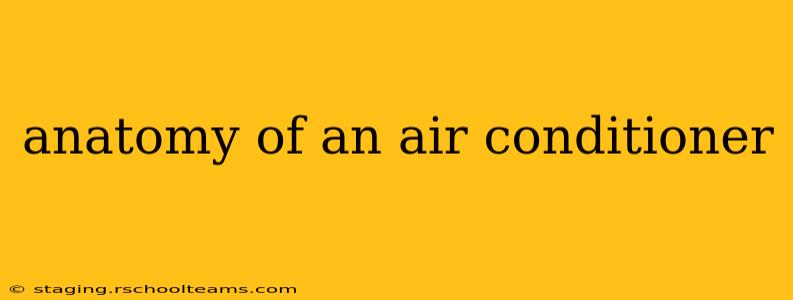Air conditioners, those ubiquitous boxes that keep us cool during sweltering summers, are surprisingly complex pieces of machinery. Understanding their anatomy can help you better maintain, troubleshoot, and appreciate the technology behind your cool comfort. This comprehensive guide explores the core components and their functions, answering many frequently asked questions along the way.
What are the main parts of an air conditioner?
An air conditioner, whether a window unit, split system, or central air system, comprises several key components working in concert. These include:
-
Refrigerant: The lifeblood of the system. This special fluid absorbs heat from inside your home and releases it outside. Different refrigerants exist, each with varying environmental impacts and efficiency levels. Modern systems are increasingly moving towards more environmentally friendly options.
-
Compressor: The powerhouse. This component compresses the refrigerant, raising its temperature and pressure. This is a crucial step in the heat transfer process. Compressor failures are a common cause of AC malfunctions.
-
Condenser: Located outside the home (in most systems), the condenser releases the heat absorbed by the refrigerant into the outside air. Think of it as a radiator for your AC unit. Its efficiency is crucial for overall system performance.
-
Expansion Valve (or metering device): This regulates the flow of refrigerant, controlling the pressure and temperature as it moves from the high-pressure side to the low-pressure side of the system. Proper expansion valve function is essential for optimal cooling.
-
Evaporator: This is the component inside your home that absorbs heat from the air. The refrigerant, now at a low temperature and pressure, evaporates, absorbing heat in the process and cooling the air blown out by the fan. Dirty evaporator coils can significantly reduce cooling efficiency.
How does an air conditioner work?
The entire system functions on a thermodynamic cycle, leveraging the properties of the refrigerant to move heat from one place to another. In short:
- Evaporation: The refrigerant absorbs heat from inside your home, cooling the air.
- Compression: The compressor increases the refrigerant's pressure and temperature.
- Condensation: The high-pressure, high-temperature refrigerant releases heat to the outside air.
- Expansion: The refrigerant's pressure drops, lowering its temperature, preparing it to begin the cycle again.
What is the difference between a window air conditioner and a central air conditioner?
The primary difference lies in scale and installation. Window units are self-contained, compact systems installed directly in a window. Central air conditioners are larger, more complex systems with components located both inside and outside the home, connected by refrigerant lines and ductwork. Central systems typically offer more even cooling and better efficiency for larger spaces.
What is the difference between a split system and a packaged unit?
Both are types of central air conditioning systems. A split system has the condenser unit located outside and the evaporator coil (along with other components) inside, usually connected to ductwork. A packaged unit has all components housed in a single outdoor unit, typically simpler to install but often less efficient.
What type of refrigerant do most air conditioners use?
Modern air conditioners are transitioning away from refrigerants with high global warming potentials (GWPs). While older systems might use R-22 (Freon), newer systems increasingly employ refrigerants like R-410A and R-32, which have lower environmental impacts. Check your system's specifications to determine the specific refrigerant used.
How do I know if my air conditioner needs repair?
Several signs indicate a potential problem: weak airflow, unusual noises (rattling, clicking, banging), refrigerant leaks (indicated by a lack of cool air or frost on the evaporator coil), or high energy bills. If you suspect an issue, it's best to contact a qualified HVAC technician.
How can I improve my air conditioner’s efficiency?
Regular maintenance is key. This includes changing air filters regularly, cleaning evaporator and condenser coils, and ensuring proper airflow around the units. Consider professional maintenance once or twice a year for optimal performance and longevity.
This detailed exploration provides a robust understanding of the anatomy and function of air conditioners. Remember, consulting with a qualified HVAC technician is crucial for installation, maintenance, and repair. They possess the expertise to ensure your system operates safely and efficiently, keeping you cool and comfortable for years to come.
